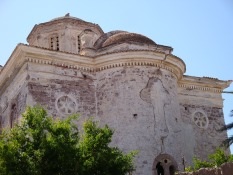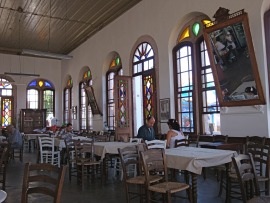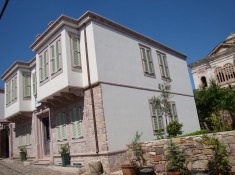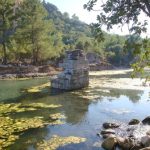Little Ayvalık Population:
Old name: Moschonisi (Greek)
Market day: Saturday
Facing Ayvalık across the bay and connected to it by a curving causeway, Cunda island was officially renamed Alibey Adası after Lieutenant-Colonel Ali Çetinkaya under whose leadership the first military shot of the Turkish War of Independence was fired in 1919. Most people still call it Cunda though. It’s an extremely popular weekend destination for locals which can mean noise and crowding, especially in high summer.
Cunda is an Ayvalık in miniature but without the modern development that hides the history and with water surrounding it on all sides. Just like Ayvalık’s, Cunda’s back streets are filled with handsome houses, some derelict but others still inhabited. Perhaps the finest is the superb Despot Evi at the eastern end of the harbour which was built in 1862 for a clergyman named Grigorious Gudohiras to celebrate Greek independence. After his death in 1877 it was used as an orphanage and primary school before being abandoned in the 1980s. After years of neglect during which it featured in several Yeşilcam films, the building was finally acquired by Polat Holdings in 2015 and turned into a heritage hotel.
Focal point is the square in front of the enormous Taksiyarhis Church (Church of the Archangels), which was damaged in an earthquake of 1944 but has now been restored to serve as a museum of local history.
 Until recently the northern shores of Cunda, around the Patrica nature reserve were virtually unknown, and for the time being this is still a good place to come in search of isolated shingle beaches despite the steady encroachment of second-homes.
Until recently the northern shores of Cunda, around the Patrica nature reserve were virtually unknown, and for the time being this is still a good place to come in search of isolated shingle beaches despite the steady encroachment of second-homes.
What were the romantic ruins of Ayışığı Manastırı (the Monastery of St Demetrios of the Moonlight), right on the waterfront, have now been restored and turned into a private house. To really get away from it all now, you need to hire a boat to take you out to Güvercin Adası and the remains of the Agios Yorgis Manastırı (St George’s Monastery).
Eating
Ayvalıklıs like to cross to the island to eat at the many harbourside fish restaurants that dish up delicacies such as papalina (a whitebait-like fish) and fried mussels served in wine, garlic and olive oil.
The most popular place to eat – and certainly the best known – is probably Bay Nihat (tel 0312-427 6363) which is housed in a 19th-century building and garners rave reviews for its mezes. Whatever you do, don’t leave without downing a tea in the Taş Kahve (the old Hermes Cafe) with its soaring ceiling and stained-glass windows – in summer swallows will probably be flying over your head if you choose to drink inside.
Sleeping
Altay
A simple pension in the busy back streets just in front the waterfront, the Altay features rooms set round a central courtyard, great for making friends but possibly a little noisy in summer.
Tel: 0266-327 1024, in**@al***********.com, Ayvalık Caddesi No. 18
Cunda Despot Evi
Luxury hotel in a historic building with a private pool and restaurant.
Tel: 0266-327 1900, www.cundadespotevi.com
Zehra Teyze’nin Evi
The most atmospheric of Cunda’s pensions is Auntie Zehra’s House facing the Taksiyarhis church. It’s a family-run place with a family atmosphere, comfortable and cheerful rather than particularly smart. The shady front garden is a delight.
Tel: 0266-327 2285
Ortunç Motel Tel: 0266-327 1120
Transport info
Regular buses ply the causeway from Ayvalık to Cunda but in summer it’s much more enjoyable (and costs the same) to take the ferry from the Ayvalık waterfront.
Day trip destinations

